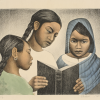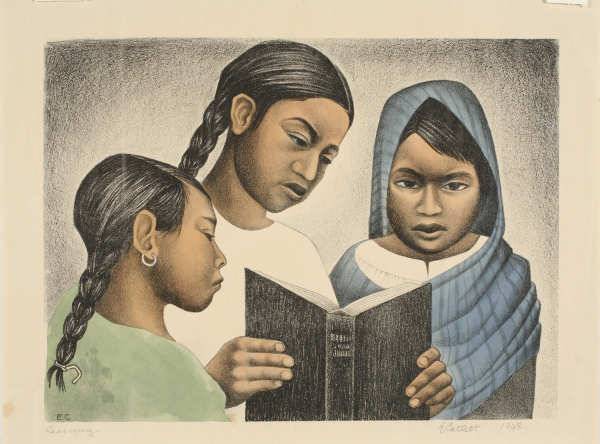Artmaking as Learning
| Grade | Kindergarten, 1st Grade, 2nd Grade, 3rd Grade, 4th Grade, 5th Grade | Class | Length of Lesson | Approximately 2 - 3 (40 - minute sessions) |
| Lesson Title | Artmaking as Learning |
| Unit Title | Artmaking as Message: Elizabeth Catlett |
| Unit Compelling Question | What is a message? |
| Historical Context: WHO: Elizabeth Catlett WHEN: 1912 - 2012 WHAT: American Printmaker, Sculptor, and Educator FAMOUS FOR: Artistic explorations of race, class, and expression of her own African American female identity. IN HER OWN WORDS: ARTIST'S HISTORY: IOWA CONNECTIONS: ARTIST'S WORK: ARTIST'S WORLD: |
|
| Lesson Supporting Question | |
| Lesson Overview | Students will learn about the life and influence of artist Elizabeth Catlett, who was the first black woman to receive an MFA, and her legacy in Iowa. Using Catlett’s artwork, Learning, 1948, as inspiration, students will discuss and analyze what it means to learn. Students will then create their own unique artwork depicting a memory of when they were learning. Finally, students will then either share with a peer and describe their artwork or write a descriptive paragraph to accompany the drawing. |
| Primary Sources Used |
|
| Resources Needed | Other Notable Artworks: Sharecropper, 1952 Mother and Child, 1956 Red Leaves, 1978 Singing Their Songs, 1992 Online Resources (Used at Instructor's Discretion): VIDEO: Elizabeth Catlett Visionary Project Video Series VIDEO: 2017 Art on Campus - "Totem" by Elizabeth Catlett VIDEO: Tyler C: Elizabeth Catlett, 'Sharecropper', 1952 | Articulation Prize 2022 PODCAST: An Alternative History of Art: Elizabeth Catlett Materials: Access to internet Print/Copy/On Screen image of artwork Learning, 1948 Drawing media (pencils, colored pencils, markers, crayons) Drawing paper (size as desired) |
| Standard | |
| Lesson Target | Students will analyze and discuss the artwork and life of artist Elizabeth Catlett and her connections to The University of Iowa in Iowa City.;Students will use a variety of drawing media to depict and reflect upon a learning experience. |
| Lesson Themes | African American Experience, Women's Experience, Civil Rights, Cultural Events, Visual Arts, Higher Education |
|
| Formative Assessment (How will you use the formative assessments to monitor and inform instruction?) |
Discussion and potential sketches of learning memories. |
| Summative Assessment (How does the lesson connect to planned summative assessment(s)?) |
Completed drawing of a learning memory, verbal discussion, or written paragraph. |
| Author | Megan Dehner | Created | Last Edited | ||||
| Reviewer: Teaching Iowa History Team | |||||||
| Lesson Plan Development Notes: Summer Fellowship 2022 | |||||||


